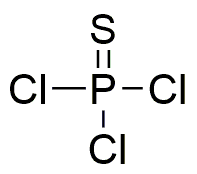Thiophosphoryl chloride is widely utilized in research focused on:
- Synthesis of Organophosphorus Compounds: It serves as a key reagent in the production of various organophosphorus compounds, which are important in agriculture as pesticides and herbicides.
- Pharmaceutical Development: This chemical is used in the synthesis of pharmaceutical intermediates, aiding in the development of drugs that target specific diseases.
- Polymer Chemistry: Thiophosphoryl chloride plays a role in modifying polymers, enhancing their properties for applications in coatings, adhesives, and sealants.
- Analytical Chemistry: It is employed in analytical methods for detecting and quantifying phosphorus-containing compounds in environmental samples, contributing to pollution monitoring.
- Research in Chemical Biology: The compound is utilized in the study of biochemical pathways, particularly in understanding the role of phosphorus in biological systems.
General Information
Properties
Safety and Regulations
Applications
Thiophosphoryl chloride is widely utilized in research focused on:
- Synthesis of Organophosphorus Compounds: It serves as a key reagent in the production of various organophosphorus compounds, which are important in agriculture as pesticides and herbicides.
- Pharmaceutical Development: This chemical is used in the synthesis of pharmaceutical intermediates, aiding in the development of drugs that target specific diseases.
- Polymer Chemistry: Thiophosphoryl chloride plays a role in modifying polymers, enhancing their properties for applications in coatings, adhesives, and sealants.
- Analytical Chemistry: It is employed in analytical methods for detecting and quantifying phosphorus-containing compounds in environmental samples, contributing to pollution monitoring.
- Research in Chemical Biology: The compound is utilized in the study of biochemical pathways, particularly in understanding the role of phosphorus in biological systems.
Documents
Safety Data Sheets (SDS)
The SDS provides comprehensive safety information on handling, storage, and disposal of the product.
Product Specification (PS)
The PS provides a comprehensive breakdown of the product’s properties, including chemical composition, physical state, purity, and storage requirements. It also details acceptable quality ranges and the product's intended applications.
Certificates of Analysis (COA)
Search for Certificates of Analysis (COA) by entering the products Lot Number. Lot and Batch Numbers can be found on a product’s label following the words ‘Lot’ or ‘Batch’.
Numéro de catalogue
Numéro de lot/série
Certificates Of Origin (COO)
This COO confirms the country where the product was manufactured, and also details the materials and components used in it and whether it is derived from natural, synthetic, or other specific sources. This certificate may be required for customs, trade, and regulatory compliance.
Numéro de catalogue
Numéro de lot/série
Safety Data Sheets (SDS)
The SDS provides comprehensive safety information on handling, storage, and disposal of the product.
DownloadProduct Specification (PS)
The PS provides a comprehensive breakdown of the product’s properties, including chemical composition, physical state, purity, and storage requirements. It also details acceptable quality ranges and the product's intended applications.
DownloadCertificates of Analysis (COA)
Search for Certificates of Analysis (COA) by entering the products Lot Number. Lot and Batch Numbers can be found on a product’s label following the words ‘Lot’ or ‘Batch’.
Numéro de catalogue
Numéro de lot/série
Certificates Of Origin (COO)
This COO confirms the country where the product was manufactured, and also details the materials and components used in it and whether it is derived from natural, synthetic, or other specific sources. This certificate may be required for customs, trade, and regulatory compliance.


